Table of Contents
Albino Bristlenose Pleco Care
An Albino Bristlenose Pleco can be kept safely in a 25–30 gallon tank with around 100–120 liters of water. These fish require enough room in the aquarium so they may move about freely. It is best to keep them in sizable tanks, especially if other tank mates are present.
Albino Bristlenose Pleco Overview
You may call it Albino Bushynose, Ancistrus dolichopterus or Bushynose Pleco. The Albino Bristlenose Pleco is found in the rivers of South America and happens to have the color version of the typical Bush Nose Pleco.
The albino bristlenose pleco can recognize food throughout the length of the rock-strewn substrate, even if the lighting conditions are poor and the food is not visible, it is visible for them. Their capability to find food in low visual range merged with their superpower to camouflage in the environment makes these species very lavish and interesting. As a very pliable and adaptable fish, the albino bristlenose pleco has no problem whatsoever to be taken from their natural and transferred into your community tank, become a great addition to your aquariums diversity.
| Information Chart | Albino Bristlenose Pleco |
|---|---|
| Scientific Name: | Ancistrus |
| Family: | Loricariidae |
| Care Level: | Easy |
| Temperament: | Peaceful |
| Color: | Bright yellow |
| Lifespan: | 5 years |
| Size: | 5 inches |
| Diet: | Omnivorous |
| Minimum Tank Size: | 25-gallon |
| Temperature: | 60℉ to 80℉ |
| Water Conditions: | Normal freshwater tanks with required water temperature, pH level(6.5 to 7.5), and hardness(2 – 12 dGH) |
| Tank Mate Compatibility | Guppies, Platies, Swordtails, etc. |
Albino Bristlenose Pleco Appearance
Albino Bristlenose Pleco is a mostly brown fish marked with light spots. They can blend in the shore and rock bottom thanks to their light-yellow or white appearance. Thanks to their whiskers on their mouth/nose it is a lot easier for them to find food. This species grows with a maximum size of 5 inches.
These fishes are flatter when compared to the common pleco. They also have a wider head. Moreover, their flat body has numerous bony plates that form armor to protect the fish from predators.
Adult Albino Plecos grow tentacle-shaped appendages from their heads. There’s also a pair of abdominal and pectoral fins, and their round, elongated mouth is perfect for sucking algae from the tank.
Albino Bristlenose Pleco Lifespan
An Albino Bristlenose Pleco lives somewhere between 3-5 years. Some fishes can also survive for seven years in exceptionally good conditions.
However, the average lifespan is about five years.
Albino Bristlenose Pleco Size
An Albino Bristlenose Pleco can grow up to 6 inches, i.e., about 15 centimeters. They are typically small fishes, and most of them do not grow more than 5 inches. The average size of an adult Albino Pleco is only about 3-4 inches (approx 10 cm).
Albino Bristlenose Pleco Natural Habitat And Origin
The Albino Bristlenose Pleco is specifically native to South America. It also lives in the freshwaters of the Amazon River basin and its surrounding areas. These fishes can easily survive in changing conditions like fast-flowing and muddy still waters. In general, the water that they thrive in is greatly oxygenated.
Albino Bristlenose Pleco Care And Tank Setup
Tank Size And Specifications
Optimum Tank Size For Albino Bristlenose Pleco
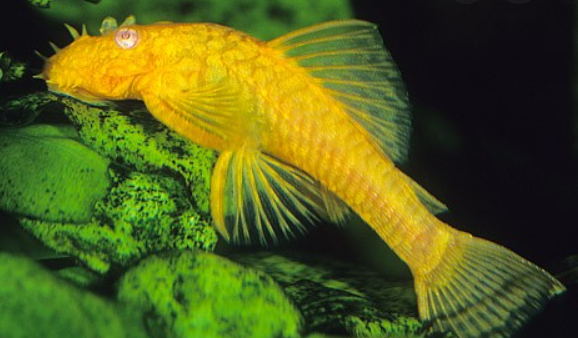
You can safely keep an Albino Bristlenose Pleco in a 25–30-gallon tank with approximately 100 to 120 liters of water. The general size for the Albino Bristlenose Plecos fish tank is 30 gallons or more. These tiny fishes need sufficient space in the tank to roam freely. Keeping them in large tanks is better, especially if other tank mates accompany them. However, for a single Albino Pleco, a 30-gallon tank is more than enough.
Tank Shape For Albino Bristlenose Pleco
A long rectangular tank is best for an Albino Bristlenose Pleco as they mostly stay at the mid-layers or bottom of the tank.
Filter Type
Considering it’s a large fish, you will need a large fish tank for the Albino Bristlenose Pleco. If you are keeping it along with other species, be mindful that the Albino Bristlenose Pleco has a large waste output, for which you will need either an even larger tank or a top-of-the-line filtration system.
Canister filters are great for removing this excess junk and cleaning the tank. However, they are quite expensive, and you will have to install a separate pre-filter to avoid baby plecos from being sucked in.
Hang on the back filters are cheaper than canister filters, but they also need a pre-filter before breeding. Sponge filters are the most inexpensive and provide an excellent surface area for biofilm growth. They are only good for large tanks.
Substrate
Bristlenose Plecos are bottom-dwellers inside a tank.
Any substrate for this fish tank must leave large open areas for the plecos to forage. Clay substrates topped with gravel are the best choice for plecos. Coarse and rough gravel can injure the lower body of the fish as they move in the bottom of the tank.
How Many Albino Bristlenose Pleco In A 3o-Gallon Tank Mate Accompany?
Albino Bristlenose Pleco in a 30-gallon tank can accompany 5-6 tankmates. If you want to increase the number or add more tank mates, it is best to get larger tanks.
Water Parameters For Albino Bristlenose Pleco
Keep a regular track of the nitrate and phosphate levels in the tank’s water. High nitrate levels can forbid your fish from eating or swimming. Change 25% of the water once every two weeks and remove any organic matter from your tank.
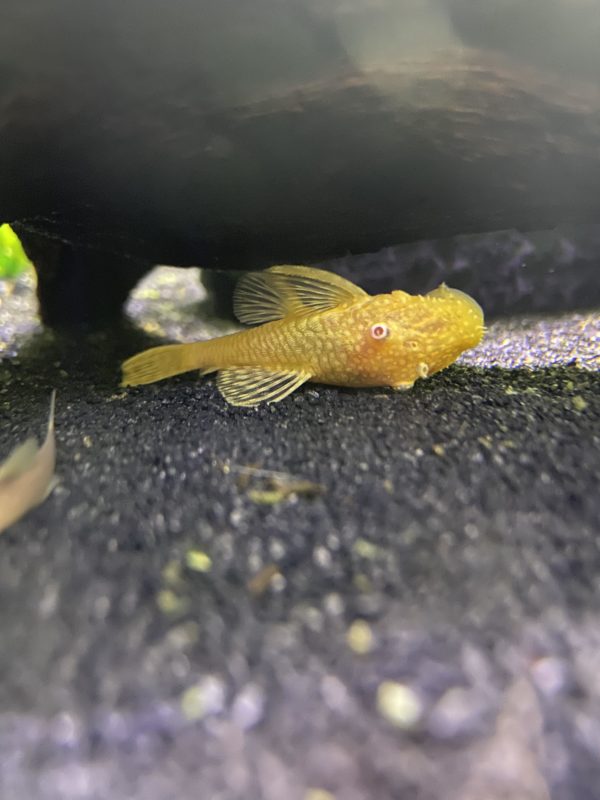
Water Temperature
Albino Plecos can withstand a wide range of temperature variations. But they can survive comfortably in a tank with a water temperature of 60℉ to 80℉.
Water Flow Rate
These fishes primarily grow in the fast-flowing waters of the Amazon River basin. You can keep them in a tank with high water flow.
pH Level
Albino Plecos are freshwater fishes, and the suitable pH level of the water should be anywhere within the range of 6.5 to 7.5.
Water Hardness
The tank’s water where Bristlenose Pleco resides should have soft to medium hardness. Anything between the 2-12 dGH range will work best for them.
Albino Bristlenose Pleco Tank Landscape
Ideal Plants for Albino Bristlenose Pleco Tank
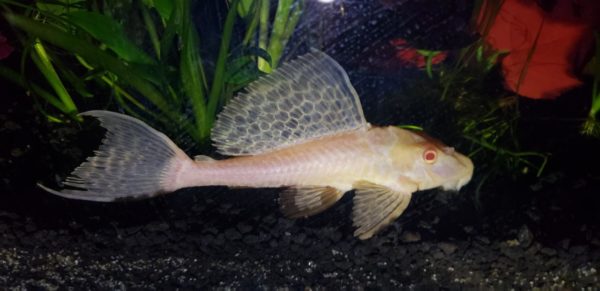
Bristlenose Plecos do not eat plants. You can keep several live plants inside the tank,
Decorations For Albino Bristlenose Pleco Tank
If you want to achieve a healthy environment for your fish, try planting some rapidly – growing plants and make sufficient space for swimming, making sure that your décor doesn’t suffocate their freedom in the aquarium. Placing some natural objects like driftwood mixed with stones makes them feel like they are in their natural river surroundings. Make sure you impart some hiding places to make their daily bases more interesting and stress-free, like creating caverns on the bottom of the tank made out of rock, etc.
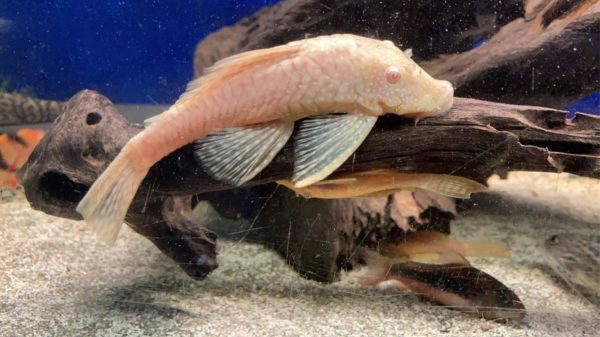
Using driftwood inside the tank of an Albino Pleco is extremely crucial. Driftwood provides a surface for algae growth, and it comes across as a major source of nutrition and fiber to the fish.
Lighting for Albino Bristlenose Pleco Tank
Albino Bristlenose Pleco is more active at night. Still, if you do a proper aquarium setup for their accommodation, they will also be active during the day.
Moderate lighting is sufficient for an Albino Pleco tank. Remember to put enough lighting for adequate growth of the plants inside the tank. Proper lighting will also encourage algae development on driftwood and other surfaces.
Too much lighting can lead to considerable algae growth, adversely affecting the fish. Not all algae are good for the fish.
Feeding Albino Bristlenose Pleco
When Albino Bristlenose Pleco is its natural habitat, it feeds on small different crustaceans, decomposed plant natural matter and of course, all kinds of worms. As I said earlier, they are a very adaptable species, so they can rapidly get used to be eating commercial fish food like sinking wafers and pellets.
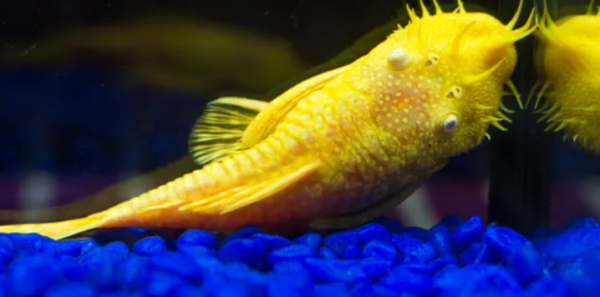
Do not worry about filtering the decomposed plant material in you aquarium, as the Albino Bristlenose Pleco will eat all of the leftovers. This fish is not a vegetarian so it will enjoy all of the meat it can possibly get like: brine shrimp, little water fleas and bloodworms; but it is best if you offer them meat in small quantities. It could also eat blanched spinach and other green vegetables.
Fish keepers must keep in mind that they are feeding fish who are eating from the bottom of the fishtank and you must be able to distribute their food in a way that the fish are accustomed to. For those types of fish who feed from the bottom, fish keepers have to be able to place the food lower in the aquarium, two or three times per week, so that the Albino Bristlenose Pleco can scavenge it as they do in their natural habitat. It is highly suggested that you make the right decisions about the frequency of their feeding based on the appearance of your fish and their health.
How Often Should You Feed Albino Bristlenose Pleco?
You can feed your Albino Bristlenose Pleco once or at most twice daily. Overfeeding can lead to a bloated stomach and other complicated health issues.
Albino Bristlenose Pleco Behavior and Temperament
Albino Plecos spend most of their time dwelling at the bottom of the tank. They also love to suck on the sides of their tank.
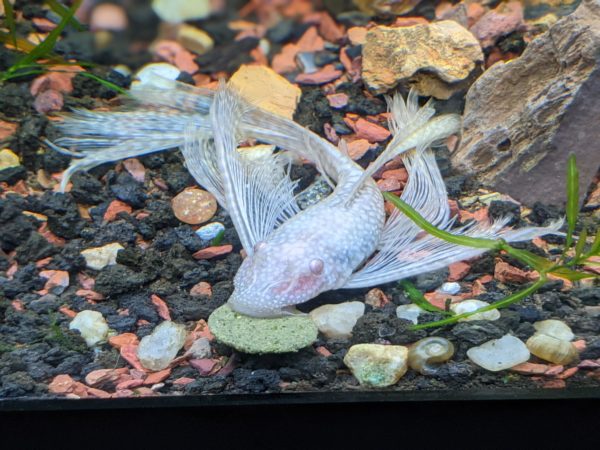
Bristlenose Plecos can camouflage very well in their natural surroundings. However, due to the bright colors of the Albino variety, camouflaging isn’t the best for them. If you find your fish in a still position for a long time, do not panic, as it is normal for them to stay without the slightest movement for hours!
These are peaceful fishes who will get along with other tank mates as long as their feeding cycle is not disturbed. Try not to include other bottom-dwellers in the same tank, as it might lead to fights for space. Other peaceful fishes who swim on the upper surfaces of the water would be great for Albino Plecos.
Are Albino Bristlenose Pleco Lonely Or Societal?
Albino Plecos can happily live alone as they have very restricted movements. They can stay alone in their shelters, motionless for hours! You can keep them with other fishes as they are not very aggressive. However, they are perfectly capable of living alone as well.
Albino Bristlenose Pleco Tank Mates
Ideal Tank Mates For Albino Bristlenose Pleco
Albino Bristlenose Pleco is compatible with many other fishes as tank mates. Here are some options,
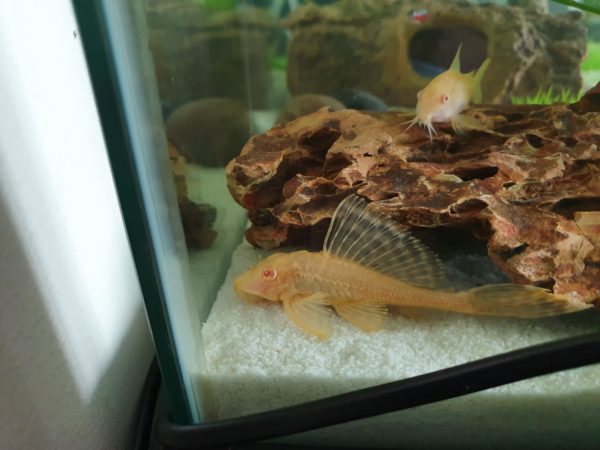
- Freshwater snails go well with Albino Plecos. They stay harmoniously together and are great tank cleaners. They remove leftover food, invasive algae, and plant matter from the bottom of the tank and keep it clean.
- Platies
- Guppies
- Endlers
- Cherry Barbs
- Swordtails
- Pigmy Cories
Worst Tank Mates For Albino Bristlenose Pleco
- Avoid keeping two male Albino Plecos together, as they can get aggressive and territorial. They also eat and destroy each others’ eggs.
- Pleco
- Avoid other aggressive fishes.
- Carbs and Crayfish
- Shrimps
Albino Bristlenose Pleco Breeding
Breeding of the Albino Bristlenose Pleco is quite easy. The only thing you have to keep in mind is that they breed usually during the winter period. They are usually known for their general loneliness, but during reproduction, their attitude changes, so they become more easy-to-interact with.
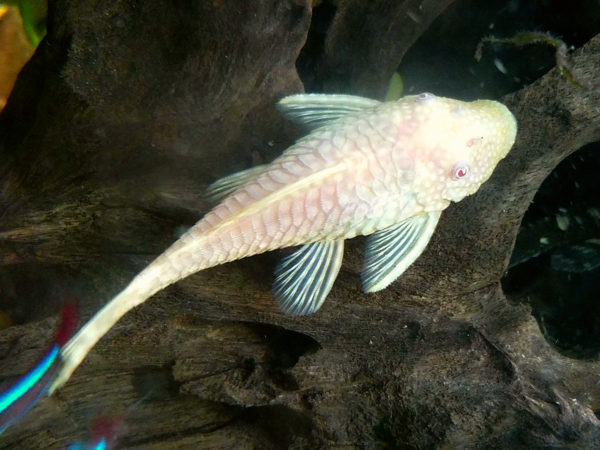
When setting them up for spawning, it is recommended to pair them with 2 females for every male. The caverns or places of hiding that they generally use will be the place where they breed, so if you are planning to breed your Albino Bristlenose Plecos, keep this in mind while you set up your aquarium for them.
Changing the water by 50% will help them insure it is the perfect time for breeding.
Feeding them live high quality food will also have a great effect on them while they breed.
The minimum aquarium size where your Albino Bristlenose Pleco can breed is 30 gallons. The temperature should be around 73° – 85° F and with a pH value of 7 pH. The female places the eggs on pieces of driftwood, so make sure you distribute plenty of driftwood around the breeding tank. After the eggs are laid you will notice that the male fish is always around them, guarding its offspring.
The Albino Bristlenose Pleco fry will hatch in a maximum period of 10 days. After hatching, they have to be removed from the breeding tank and placed in a different aquarium. You should offer the fry mashed and fresh green vegetables.
Breeding Level
Easy

Sexual Dimorphism
As juveniles, distinguishing a male Albino Pleco from a female is very difficult. After they are four to six months old, some stark differences show between the genders.
Another interesting fact about the Albino Bristlenose Pleco is the difference in growth of their appendages between the males and the females. The length is more noticeable at the male fish! Also, the male Albino Bristlenose Pleco can be a little bit territorial with other males from its species!
Albino Bristlenose Pleco Common Diseases And Their Treatments
Albino Bristlenose Plecos are usually very hardy fishes. Their protective armor plating prevents them from knocks and scratches while dwelling at the bottom. They seldom suffer from bacterial infections.
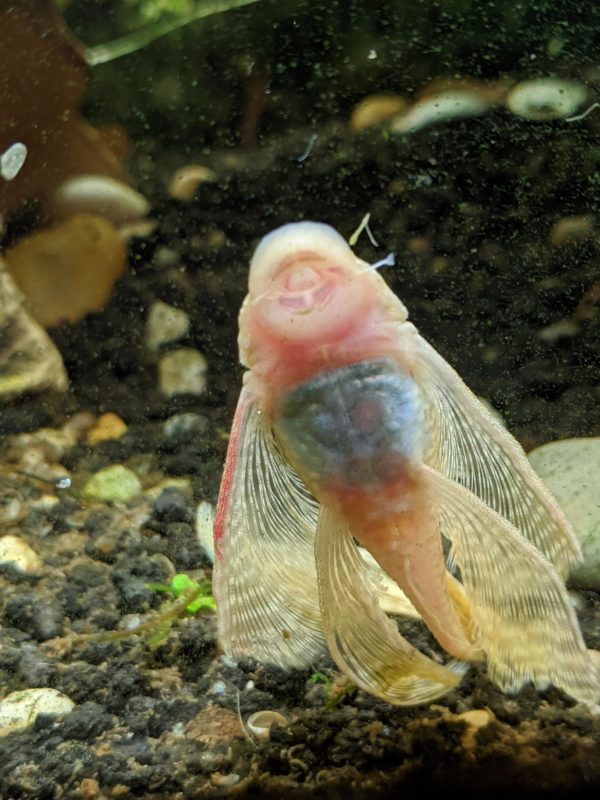
However, high ammonia and nitrate levels in the water can be the reason for stress among these fishes. They can also cause serious bacterial, fungal, and parasitic infections.
Ich is a disease that can affect tropical freshwater fish like the Albino Bristlenose. The condition is caused by a parasite inside the water that grows due to poor conditions. Ich is the best example of why you should clean your tank thoroughly even after having tank cleaner fishes like Albino Plecos.
Overfeeding the Albino can lead to intestinal blockages and severe digestive issues. Such conditions can even become fatal quickly. Make sure to put them back on a proper diet immediately.
Quarantine new fishes in a separate tank for two days to ensure that the fish are healthy. Wash your decorations like driftwood and other items properly before finally putting them inside the tank.
Interesting Facts about Albino Bristlenose Pleco
- This species is extremely tranquil and strong.
- Their size makes them very optimal and manageable for your aquarium tank.
- They also control the spreading of algae, especially when they are younger.
- You can forget about leftover food in your community tank as they will eat all of it. However, overfeeding your Albinos can lead to serious fatal diseases.
- Their appearance is not like any other fish out there, so they will contribute greatly to the physical diversity of your aquarium.
- They are also called suckerfish as they can sometimes stick to the sides of the aquarium and suck on the sides of the tank.
- Albino Plecos can happily stay alone as they do not have a lot of movement or activity inside the tank.
- The average lifespan of an Albino Bristlenose Pleco is about five years.
- These are great for a community tank as they can stay with other fishes peacefully.
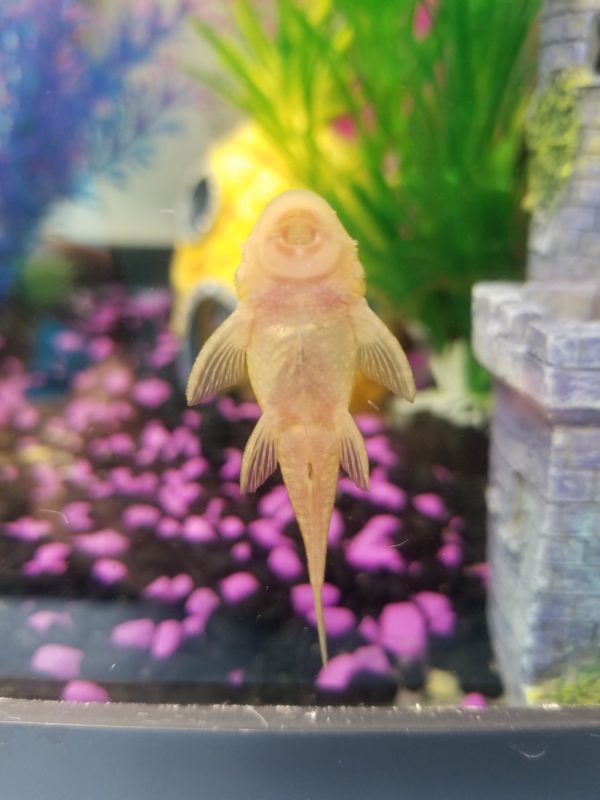
FAQs
How Long Do Albino Bristlenose Plecos Live?
Albino Bristlenose Plecos can live up to 5 years or more.
What Do Albino Bristlenose Plecos Eat?
Albino Bristlenose Plecos are omnivores that eat plants, vegetable matter, algae, and small portions of frozen or dried meat protein.
Are Albino Plecos Rare?
Yes, Albino Plecos are pretty rare because of their geographical distribution. They have a lot of predators in the wild, and it is challenging to find them in stores as well.
Can An Albino Pleco Live In A 20-Gallon Tank?
Yes, an Albino Pleco can survive in a 20-gallon tank, but it is best to keep them in larger tanks as they need more space to move freely.
Conclusion
Albino Bristlenose Plecos are affordable, low maintenance, hardy fishes suitable for freshwater tanks. They can also live inside a community tank with other peaceful fishes that dwell in the middle or upper layers of the water.
These suckerfish will also clean up your tank by feeding on the algae and eating leftover scraps. They are pretty easy to keep and add a picturesque charm to your aquarium.
No related posts.
